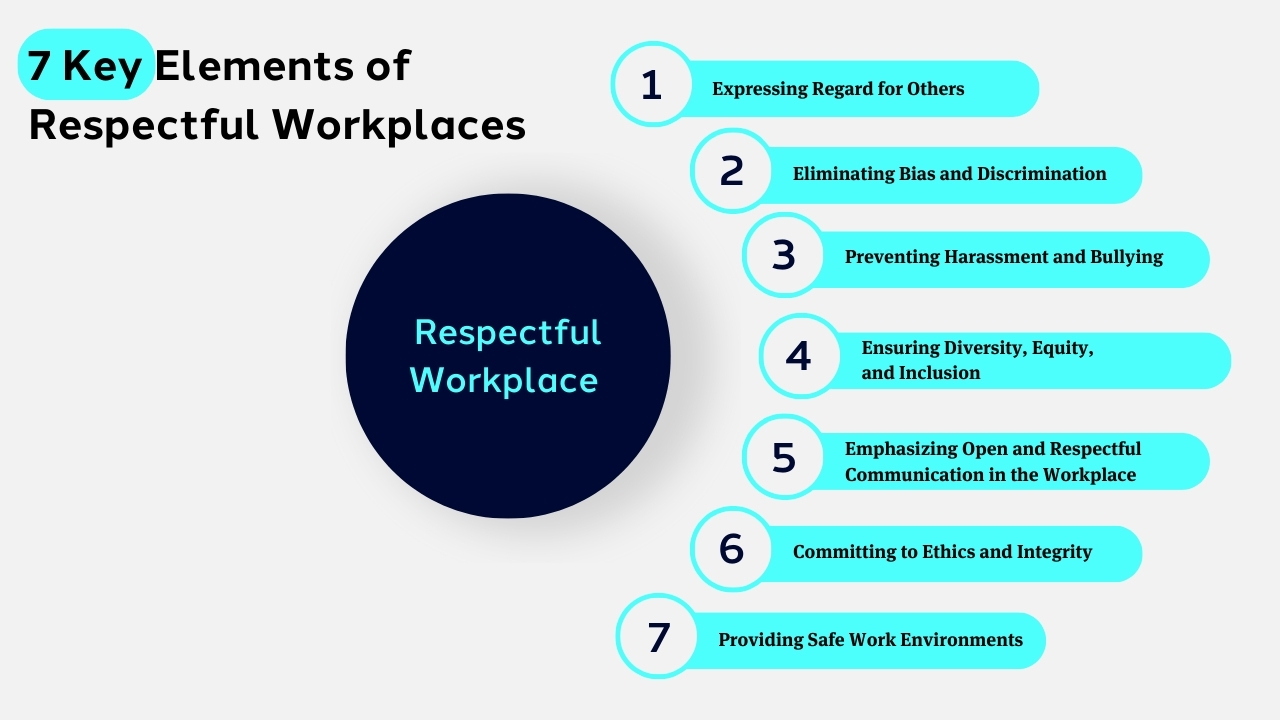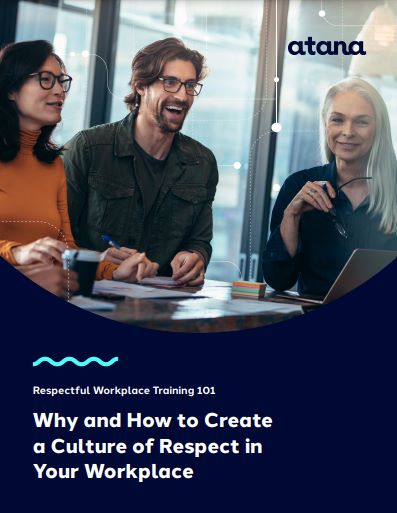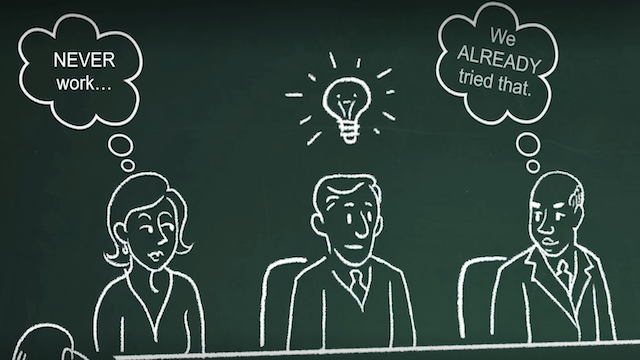
What is Respect in the Workplace?
A workplace characterized by trust and the respectful treatment of employees leads to greater job satisfaction, productivity, and employee engagement.
Positive work environments also impact the bottom line through an increase in creativity and innovation, retention rates, attraction of top talent, and overall workforce well-being.
But respectful workplaces don’t just happen. Positive culture change requires careful planning and execution, as well as support from various sources, to establish and evolve core elements.
Organizations committed to creating a positive environment align various aspects of the business around the overarching goal of valuing all people and treating them fairly. These areas include:
- Company culture
- Talent policies
- Benefits and compensation
- Organizational values
To create this alignment, respectful workplaces are built on seven key elements.
Respect in the workplace means creating a trust-driven environment where employees are valued, leading to higher satisfaction, productivity, and success.
7 Key Elements of Respectful Workplaces
Respectful workplaces offer safe environments that strive to be free of such negative behaviors as harassment, bullying, bias, discrimination, incivility and even violence. They are built on seven key elements:
1. Expressing Regard for Others
Regard for others means genuinely caring about their perspectives, strengths, and challenges, and treating everyone fairly and with dignity. It's essential for building trust and requires respect, integrity, and accountability.
Key behaviors include:
- Recognizing each person's unique perspective and knowledge
- Considering different opinions and controlling the Rebuttal Brain (which automatically forms critical or negative thoughts about what others are saying)
- Acting in ways that build people up versus tearing them down (such as refusing to participate in gossip)
- Adopting a look-out-for-one-another mindset (such as following safety protocols)
- Avoiding work practices that undermine a person's ability to maintain a healthy work-life balance
2. Eliminating Bias and Discrimination
The Society for Human Resource Management (SHRM) says that “most people have some type of hidden bias” that can surface at work.
Bias involves favoring (or disliking) something—a person, way of behaving, opinion, group, etc.—over another. Teaching people to identify their unconscious biases and how to reframe them is a fundamental element of creating a fair environment. When biases aren’t addressed, they can cause discrimination. Discrimination ranges from subtle (disparaging remarks or offensive jokes) to blatant behaviors (exclusion from meetings, pay inequities, career limitations, or job loss).
According to SHRM, discrimination and biases erode employee “productivity and engagement.” They also negatively impact “morale, motivation, commitment, and desire to advance” in an organization.
Discrimination in any form demoralizes individuals and leaves an organization vulnerable to potential litigation. The U.S. Equal Employment Opportunity Commission (EEOC) enforces laws related to discrimination in employment based on race, color, religion, sex, national origin, age, disability and genetic information.
3. Preventing Harassment and Bullying
Harassment, according to the EEOC, is unwelcome conduct based on various characteristics. The behavior is unlawful when employees must endure it in order to remain employed, or when the conduct is so harsh and pervasive that it creates an intimidating, hostile, or abusive environment.
The kinds of behaviors that could become harassment, include:
- Racial slurs or insults
- Gender-based stereotypes
- Religious intolerance
- Improper treatment of people with disabilities
- Inappropriate comments and offensive jokes
Sexual Harassment is a particularly pervasive and harmful type of harassment.
Harassment is unwelcome conduct based on various characteristics.
Bullying is abusive conduct in the workplace that occurs over time. Workplace bullying may consist of verbal abuse, threats, humiliation or other forms of intimidation. It can damage the health of victims and interfere with their ability to perform their jobs. The mistreatment can involve one or multiple perpetrators and may affect one or several victims.
Harassing or bullying behavior can stem from either deliberate power and intimidation or from ignorance. Regardless, the harm it causes the target must be stopped.
Enabling people to recognize inappropriate behaviors and speak up for themselves and others is key to preventing harassment and maintaining a respectful work environment.
4. Ensuring Diversity, Equity, and Inclusion (DE&I)
Diversity, Equity, and Inclusion (DE&I) are three related, but distinct, elements of a positive work environment.
Diversity describes a workforce that reflects differences across a variety of characteristics. Those characteristics can include age groups, races, ethnicities, cultures, religions, sexual orientations, economic and educational levels, and abilities.
Equity is about fair treatment for everyone. It emphasizes revealing and removing unfair barriers and differences in treatment of team members. This may include paying attention to whose ideas are most respected by others or who speaks most often in meetings.
Inclusion is a term linked to diversity. It is the sense of feeling welcome and comfortable, of belonging. Inclusive companies let all employees know they are valued and respected. One way to create inclusion in the workplace is to ensure that people from various backgrounds are part of the process of refining existing products and services and developing new ones.
Greater levels of creativity and innovation are associated with diverse workforces. DE&I also leads to improvements in employee engagement, retention, and problem-solving. The presence of a diverse workforce can contribute to an organization's reputation, too, by strengthening employer and product branding and increasing customer satisfaction.
5. Emphasizing Open and Respectful Communication in the Workplace
Communication is the means by which people exchange information. Open and respectful communication enables an organization to:
- Impart knowledge required for successful job performance
- Ensure that everyone understands the organization’s mission and values
- Create positive employee-to-coworker and employee-to-leader connections
- Build relationships with customers
Effective communication is more than just talking and writing. It's also about actively listening, understanding body language, adapting your communication style when needed, and being empathetic. At work, it includes being fair, trustworthy, resolving conflicts, and building good relationships with coworkers.
6. Committing to Ethics and Integrity
Defining ethics as “the values an organization demonstrates in its goals, policies and practices,” SHRM says that ethics “are the heart of any workplace culture and [determine] the quality of experience in an organization.”
Integrity means acting in accordance with personal and organizational values.
In positive work environments, ethics and integrity are core drivers of employee behavior. Individuals who act with integrity are reliable and trustworthy. These team members behave in the following ways:
- Apply ethics to guide their decision-making
- Honor their promises
- Perform their assigned work
- Respect their co-workers, their leaders, and their employer
- Speak out against discrimination, misbehavior, and inappropriate conduct
Ethics and integrity also influence business success. SHRM reports that companies with highly ethical cultures significantly outperform competitors. These organizations have greater employee satisfaction and commitment, lower turnover, reduced legal risk, and more high-potential talent.
7. Providing Safe Work Environments
Employee health and safety is mandated and enforced by multiple agencies of the United States government. Employers must provide workplaces that are free of known safety and health hazards, and give employees the right to report violations without fear of retaliation.
At its most basic level, workplace safety is about preventing workforce injuries and deaths. It includes reducing lost time due to illness and injuries, legal risks, and workers' compensation claims.
Workplace well-being also aims to prevent and respond to violence, including verbal abuse, threats, physical assaults, and active-shooter situations. According to OSHA, workplace violence includes "any act or threat of physical violence, harassment, intimidation, or disruptive behavior at the worksite".
Safety is a key element of a respectful work environment. It can boost morale and employee confidence, reduce stress, encourage workers to address unsafe conditions, and improve company culture.


How Respectful Workplace Training Benefits Organizations and Individuals (and Helps Them Avoid Risks)
Purposeful organizational policies and effective respectful workplace training can help replace negative behaviors like bullying, discrimination, and harassment with respectful actions and attitudes. Some of the most commonly cited benefits (and risks) include:
- Improved employee retention (decreased turnover). Retaining existing employees is a cost-saver for organizations, a must-do in tight talent markets, and contributes to lower levels of disruption in business operations.
Risk avoided: Some sources estimate U.S. businesses are losing up to a trillion dollars every year due to employee voluntary turnover.
- Higher levels of employee engagement. Providing a respectful work environment allows workers to feel safe and valued—creating an atmosphere that nurtures engagement.
Risk avoided: The cost of disengagement. Each year, the estimated loss to the U.S. economy from employee disengagement is as much as $350 billion. Further, Gallup research found 37% more absenteeism and 15% lower productivity in organizations where workers are disengaged.
- Increased productivity and performance. Organizations that demonstrate respect through a culture centered on communication, accountability and care see a 4x increase in revenue growth.
Risk avoided: Without a culture of respect, increased employee output and higher-caliber performance are less likely to be achieved. Still, less than 50% of U.S. employees say they work in a positive culture.
- Greater employee job satisfaction and well-being. In respectful workplaces, employees report higher levels of satisfaction with their work and are likely to experience less job-related stress.
Risk avoided: Research into workplace disrespect found that 78% of employees said their commitment to the organization declined due to workplace incivility, with 12% claiming to have left their job due to uncivil treatment.”
- More effective collaboration, communication, and knowledge-sharing. When colleagues make commitments to act courteously and with civility, encourage others to share their ideas, and take pains to communicate openly and honestly, they ensure the circumstances work groups need to succeed.
Risk avoided: Research notes that employees who experience incivility on the job are “three times less likely to help someone else, and their willingness to share drops by more than 50%.”
The preceding list highlights some of the most-sought benefits associated with respectful workplaces, but it is by no means complete. Companies and individuals may gain in many other ways when organizations leverage effective respectful workplace training to help leaders and employees build the skills and perspectives that sustain positive company cultures.
What is a Respectful Workplace?
Respectful workplaces offer safe environments that strive to be free of such negative behaviors as harassment, bullying, bias, discrimination, incivility and even violence. They are built on several key elements, including:
- Expressing regard for others—genuinely caring about their perspectives, strengths, and challenges, and treating everyone fairly and with dignity.
- Eliminating bias and discrimination
- Preventing harassment and bullying
- Building inclusion
- Emphasizing open and respectful communication
- Committing to ethics and integrity
- Providing physically and psychologically safe work environments
- Developing positive, proactive leaders
SHRM research puts the five-year cost of toxic workplace cultures for U.S. employers at $223 billion. Despite this, many employers do not focus enough on creating a positive work environment.
Convincing leaders with budget approval that building a culture of respect is not just a good idea, but also a sound investment in the business relies on the language of business—numbers.
Whether making the case for training, or any other development intervention designed to support a respectful workplace, metrics must demonstrate business-critical factors that are affected by workplace culture.
HR and L&D professionals should be prepared to answer such general questions as:
- What will the training cost (in money and time)?
- What kind of return on that investment is expected?
- How many people need/will receive the training?
- How will the training move the needle on key performance indicators (KPIs) for the organization?
To answer these questions, HR and L&D professionals should use both internal and external data.
Common Types of Internal Metrics for Business Cases
Internal metrics are created by the organization’s day-to-day operations. These metrics can help demonstrate the return on investment and are likely connected to the business’s KPIs'
- Revenues/cost reductions
- Productivity/output
- Organizational/individual performance
- Turnover rates/retention rates
- Legal actions filed
- Diversity and inclusion
- Employee engagement
- Culture change/reinforcement
- Talent attraction/acquisition
- Safety/security measures
Some measures that reflect employee attitude and behavioral changes might include:
- Individual performance levels/ratings
- Job satisfaction/loyalty
- Employees’ stress levels
- Productivity levels
- Quality of work
- Communication effectiveness
- Collaborative effectiveness/teamwork
- Professional development (new knowledge/skills)
The specific figures needed to secure support for respectful workplace training will vary between organizations. They shift based on things like business goals, imperatives, and compliance requirements.
For instance, an organization plagued by legal claims of harassment will want to closely track the number of actions and potential financial and talent risks they could cause. In a company where turnover among high-potential female talent has spiked due to lack of career-advancement opportunities, metrics that track talent mobility by gender, high-potential turnover, and percentages of women in succession pipelines are relevant.
External Statistics and Research Can Strengthen Business Cases
Beyond an organization's internal numbers, statistics available from credible outside sources can further strengthen the case for training on respect. This data may include industry benchmarks, perspectives of business leaders and employees, and figures tracked by government agencies, media outlets, and industry or professional organizations.
For example, the EEOC tracks job-related data on minorities and women, employment discrimination actions nationwide, and multiple topics related to diversity.
Other federal entities (such as OSHA or the U.S. Department of Labor) and state agencies collect data related to their specific missions.
Professional associations like SHRM and ATD (the Association for Talent Development) sponsor research and track statistical information related to workplace respect and organizational culture.
Once an HR, L&D, or other professional charged with building a culture of respect has received approval for respectful workplace training, a smart first step is self-education. A quick-start overview can be gained by reviewing a resource such as Atana's Respectful Workplace ebook which provides topic information, how-tos and relevant data.
In addition to content decisions, an organization will need to be determine its educational approach. Elements to consider include:
Once an HR, L&D, or other professional charged with building a culture of respect has received approval for respectful workplace training, a smart first step is self-education. A quick-start overview can be gained by reviewing a resource such as Atana's Respectful Workplace ebook which provides topic information, how-tos and relevant data.
In addition to content decisions, an organization will need to be determine its educational approach. Elements to consider include:
Video-based courses provide practical ideas and—as the video clip below shows— bite-sized visual examples for key concepts, techniques and tactics.
This clip from the How Was Your Day? training course (© Atana 2024) depicts how a "Rebuttal Brain" blocks inclusion and teaches 2 steps for overcoming it.
Engaging training like this helps organizations begin to implement plans for building trust, emphasizing fairness, and expressing value for the skills and perspectives every employee brings to work.
Infographics use graphic images to make definitions and key statistics easier-to-understand. In many instances, infographics also serve as point-of-need job aids.
Hands-on interactive tools include online quizzes and assessments that can make learning about challenging topics more entertaining.
When it comes to the workplace of the future, visions and predictions abound, suggesting that much will change. One key speculation is that businesses will find their competitive advantages more and more rooted in the cultures they create and embody, and in the people they employ to accomplish their missions. Increasingly, business leaders are seeing this prediction come true.
Regardless of the specific changes that reshape the business world, the desire for a respectful workplace will remain constant. Whether executing their duties today, five years from now, or a decade or more into the future, people want to work for organizations where they can be authentic, valued, appreciated for their diversity, and perform their jobs in an atmosphere of safety, camaraderie and mutual regard.
A CEO specializing in workforce motivation sums up the future of the respectful workplace this way: "The responsibility to provide a work environment where every employee feels included falls on the organization. Ultimately, companies that put employees first, recognize and appreciate them as their greatest assets, and foster humanity to allow for an individual to remain fulfilled in their current job, will reap the greatest benefits."
Preparing for a future workplace where respect is emphasized begins with establishing that kind of environment and company culture today. Leveraging best practices and tools to train employees and leaders at all organizational levels is critical to ensuring that everyone thinks and talks about the key elements of respectful workplaces in the same way.
Recommended Training
Recommended Training
Atana's Respectful Workplace Solution lets you transform required training on compliance, leadership, and culture topics into strategic insights. Behavioral questions asked during relevant learning moments capture what employees truly think and how they're likely to act.
This unique approach reveals what traditional surveys miss, enabling you to drive meaningful change, enhance workplace culture, and make more informed decisions—all through your existing L&D platform. The solution consists of four eLearning courses and Atana Insights analytics.
.
HOW WAS YOUR DAY?
ONCE & FOR ALL
UNINTENTIONAL STILL HURTS
GETTING REAL ABOUT WORKPLACE VIOLENCE
Diversity and Inclusion, Unconscious Bias, and Harassment
Sexual Harassment Prevention
Unconscious Bias
Workplace Violence Prevention and Response










